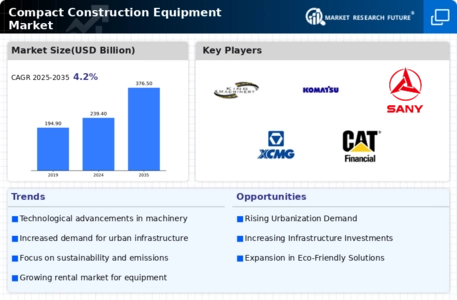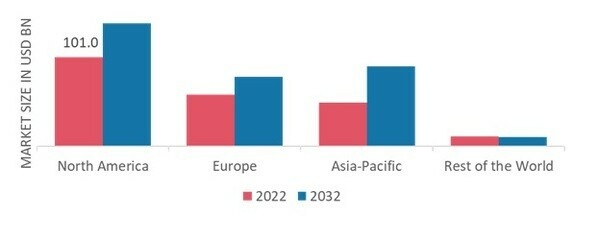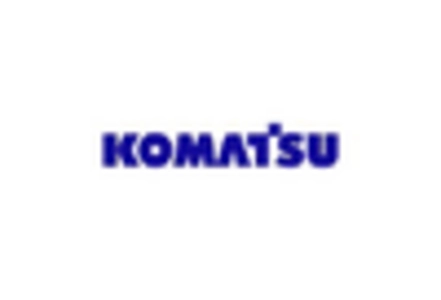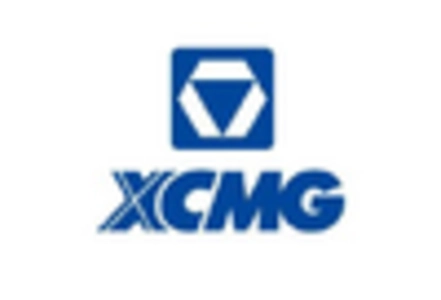-
EXECUTIVE SUMMARY
-
MARKET INTRODUCTION
-
Definition
-
Scope of the Study
- Research
- Assumptions
- Limitations
-
Objective
-
RESEARCH METHODOLOGY
-
Overview
-
Data Mining
-
Secondary Research
-
Primary Research
- Primary
- Breakdown of Primary
-
Interviews and Information Gathering Process
-
Respondents
-
Forecasting Model
-
Market Size Estimation
- Bottom-Up Approach
- Top-Down Approach
-
Data Triangulation
-
Validation
-
MARKET DYNAMICS
-
Overview
-
Drivers
-
Restraints
-
Opportunities
-
MARKET FACTOR ANALYSIS
-
Value Chain Analysis
-
Porter’s Five Forces Analysis
- Bargaining Power
- Bargaining Power of Buyers
- Threat
- Threat of Substitutes
- Intensity
-
of Suppliers
-
of New Entrants
-
of Rivalry
-
COVID-19 Impact Analysis
- Market Impact
- Regional Impact
- Opportunity and Threat
-
Analysis
-
Analysis
-
GLOBAL COMPACT CONSTRUCTION EQUIPMENT MARKET, BY TYPE
-
Overview
-
Mini Excavators
-
Compact Wheel
-
Loaders
-
Compact Track Loaders
-
Skid Steer Loaders
-
Others
-
GLOBAL COMPACT CONSTRUCTION EQUIPMENT MARKET,
-
BY APPLICATION
-
Overview
-
Construction
-
Mining
-
Agriculture
-
Others
-
GLOBAL COMPACT
-
CONSTRUCTION EQUIPMENT MARKET, BY REGION
-
Overview
- US
- Canada
-
North America
-
Europe
- Germany
- France
- UK
- Spain
- Rest of Europe
-
Italy
-
Asia-Pacific
- China
- India
- Japan
- Australia
- Rest of Asia-Pacific
-
South Korea
-
Rest of the World
- Middle East
- Africa
- Latin America
-
COMPETITIVE LANDSCAPE
-
Overview
-
Competitive Analysis
-
Market Share Analysis
-
Major Growth Strategy in the Global COMPACT CONSTRUCTION EQUIPMENT
-
Market,
-
Competitive Benchmarking
-
Leading Players
-
in Terms of Number of Developments in the Global COMPACT CONSTRUCTION EQUIPMENT
-
Market,
-
Key developments and Growth Strategies
- Merger & Acquisitions
- Joint Ventures
-
New Application Launch/Service Deployment
-
Major Players Financial Matrix
- Sales & Operating Income, 2022
- Major Players
-
R&D Expenditure. 2022
-
COMPANY PROFILES
-
KING
- Company Overview
- Financial Overview
- Applications Offered
- Key Developments
- SWOT Analysis
- Key Strategies
-
MACHINERY.
-
KOMATSU
- Company Overview
- Financial Overview
- Applications Offered
- Key Developments
- SWOT Analysis
- Key Strategies
-
LTD
-
AB VOLVO
- Company Overview
- Financial Overview
- Applications Offered
- Key Developments
- Key Strategies
-
SWOT Analysis
-
SANY GROUP
- Company Overview
- Financial Overview
- Key Developments
- SWOT
- Key Strategies
-
Applications Offered
-
Analysis
-
XCMG GROUP
- Company Overview
- Financial Overview
- Key Developments
- SWOT
- Key Strategies
-
Applications Offered
-
Analysis
-
CATERPILLAR, INC
- Company Overview
- Financial Overview
- Applications Offered
- Key Developments
- Key Strategies
-
SWOT Analysis
-
DEERE & COMPANY.
- Company Overview
- Financial Overview
- Applications Offered
- Key Developments
- Key Strategies
-
SWOT Analysis
-
HYUNDAI HEAVY INDUSTRIES
- Company Overview
- Financial Overview
- Applications Offered
- Key Developments
- SWOT Analysis
- Key Strategies
-
CO. LTD.
-
MANITOU
- Company Overview
- Financial Overview
- Applications Offered
- Key Developments
- SWOT Analysis
- Key Strategies
-
BF
-
S.A.
- Company Overview
- Financial Overview
- Applications Offered
- Key Developments
- SWOT Analysis
- Key Strategies
-
(MUSTANG)
-
J
- Company Overview
- Applications Offered
- SWOT Analysis
- Key Strategies
-
C BAMFORD EXCAVATORS LTD
-
Financial Overview
-
Key Developments
-
APPENDIX
-
References
-
Related Reports
-
LIST OF TABLES
-
GLOBAL COMPACT CONSTRUCTION EQUIPMENT
-
MARKET, SYNOPSIS, 2025-2034
-
GLOBAL COMPACT CONSTRUCTION EQUIPMENT
-
MARKET, ESTIMATES & FORECAST, 2025-2034 (USD BILLION)
-
GLOBAL
-
COMPACT CONSTRUCTION EQUIPMENT MARKET, BY TYPE, 2025-2034 (USD BILLION)
-
GLOBAL COMPACT CONSTRUCTION EQUIPMENT MARKET, BY APPLICATION, 2025-2034
-
(USD BILLION)
-
NORTH AMERICA: COMPACT CONSTRUCTION EQUIPMENT MARKET,
-
BY TYPE, 2025-2034 (USD BILLION)
-
NORTH AMERICA: COMPACT CONSTRUCTION
-
EQUIPMENT MARKET, BY APPLICATION, 2025-2034 (USD BILLION)
-
US:
-
COMPACT CONSTRUCTION EQUIPMENT MARKET, BY TYPE, 2025-2034 (USD BILLION)
-
US: COMPACT CONSTRUCTION EQUIPMENT MARKET, BY APPLICATION, 2025-2034 (USD
-
BILLION)
-
CANADA: COMPACT CONSTRUCTION EQUIPMENT MARKET, BY TYPE,
-
CANADA: COMPACT CONSTRUCTION EQUIPMENT
-
MARKET, BY APPLICATION, 2025-2034 (USD BILLION)
-
EUROPE: COMPACT
-
CONSTRUCTION EQUIPMENT MARKET, BY TYPE, 2025-2034 (USD BILLION)
-
TABLE
-
EUROPE: COMPACT CONSTRUCTION EQUIPMENT MARKET, BY APPLICATION, 2025-2034 (USD
-
BILLION)
-
GERMANY: COMPACT CONSTRUCTION EQUIPMENT MARKET, BY TYPE,
-
GERMANY: COMPACT CONSTRUCTION EQUIPMENT
-
MARKET, BY APPLICATION, 2025-2034 (USD BILLION)
-
FRANCE: COMPACT
-
CONSTRUCTION EQUIPMENT MARKET, BY TYPE, 2025-2034 (USD BILLION)
-
TABLE
-
FRANCE: COMPACT CONSTRUCTION EQUIPMENT MARKET, BY APPLICATION, 2025-2034 (USD
-
BILLION)
-
ITALY: COMPACT CONSTRUCTION EQUIPMENT MARKET, BY TYPE,
-
ITALY: COMPACT CONSTRUCTION EQUIPMENT
-
MARKET, BY APPLICATION, 2025-2034 (USD BILLION)
-
SPAIN: COMPACT
-
CONSTRUCTION EQUIPMENT MARKET, BY TYPE, 2025-2034 (USD BILLION)
-
TABLE
-
SPAIN: COMPACT CONSTRUCTION EQUIPMENT MARKET, BY APPLICATION, 2025-2034 (USD
-
BILLION)
-
UK: COMPACT CONSTRUCTION EQUIPMENT MARKET, BY TYPE,
-
UK: COMPACT CONSTRUCTION EQUIPMENT MARKET,
-
BY APPLICATION, 2025-2034 (USD BILLION)
-
REST OF EUROPE: COMPACT
-
CONSTRUCTION EQUIPMENT MARKET, BY TYPE, 2025-2034 (USD BILLION)
-
TABLE
-
REST OF EUROPE: COMPACT CONSTRUCTION EQUIPMENT MARKET, BY APPLICATION, 2025-2034
-
(USD BILLION)
-
ASIA-PACIFIC: COMPACT CONSTRUCTION EQUIPMENT MARKET,
-
BY TYPE, 2025-2034 (USD BILLION)
-
ASIA-PACIFIC: COMPACT CONSTRUCTION
-
EQUIPMENT MARKET, BY APPLICATION, 2025-2034 (USD BILLION)
-
JAPAN:
-
COMPACT CONSTRUCTION EQUIPMENT MARKET, BY TYPE, 2025-2034 (USD BILLION)
-
JAPAN: COMPACT CONSTRUCTION EQUIPMENT MARKET, BY APPLICATION, 2025-2034
-
(USD BILLION)
-
CHINA: COMPACT CONSTRUCTION EQUIPMENT MARKET,
-
BY TYPE, 2025-2034 (USD BILLION)
-
CHINA: COMPACT CONSTRUCTION
-
EQUIPMENT MARKET, BY APPLICATION, 2025-2034 (USD BILLION)
-
INDIA:
-
COMPACT CONSTRUCTION EQUIPMENT MARKET, BY TYPE, 2025-2034 (USD BILLION)
-
INDIA: COMPACT CONSTRUCTION EQUIPMENT MARKET, BY APPLICATION, 2025-2034
-
(USD BILLION)
-
AUSTRALIA: COMPACT CONSTRUCTION EQUIPMENT MARKET,
-
BY TYPE, 2025-2034 (USD BILLION)
-
AUSTRALIA: COMPACT CONSTRUCTION
-
EQUIPMENT MARKET, BY APPLICATION, 2025-2034 (USD BILLION)
-
SOUTH
-
KOREA: COMPACT CONSTRUCTION EQUIPMENT MARKET, BY TYPE, 2025-2034 (USD BILLION)
-
SOUTH KOREA: COMPACT CONSTRUCTION EQUIPMENT MARKET, BY APPLICATION,
-
REST OF ASIA-PACIFIC: COMPACT CONSTRUCTION
-
EQUIPMENT MARKET, BY TYPE, 2025-2034 (USD BILLION)
-
REST OF ASIA-PACIFIC:
-
COMPACT CONSTRUCTION EQUIPMENT MARKET, BY APPLICATION, 2025-2034 (USD BILLION)
-
REST OF THE WORLD: COMPACT CONSTRUCTION EQUIPMENT MARKET, BY TYPE,
-
REST OF THE WORLD: COMPACT CONSTRUCTION
-
EQUIPMENT MARKET, BY APPLICATION, 2025-2034 (USD BILLION)
-
MIDDLE
-
EAST: COMPACT CONSTRUCTION EQUIPMENT MARKET, BY TYPE, 2025-2034 (USD BILLION)
-
MIDDLE EAST: COMPACT CONSTRUCTION EQUIPMENT MARKET, BY APPLICATION,
-
AFRICA: COMPACT CONSTRUCTION EQUIPMENT
-
MARKET, BY TYPE, 2025-2034 (USD BILLION)
-
AFRICA: COMPACT CONSTRUCTION
-
EQUIPMENT MARKET, BY APPLICATION, 2025-2034 (USD BILLION)
-
LATIN
-
AMERICA: COMPACT CONSTRUCTION EQUIPMENT MARKET, BY TYPE, 2025-2034 (USD BILLION)
-
LATIN AMERICA: COMPACT CONSTRUCTION EQUIPMENT MARKET, BY APPLICATION,
-
LIST OF FIGURES
-
RESEARCH
-
PROCESS
-
MARKET STRUCTURE FOR THE GLOBAL COMPACT CONSTRUCTION
-
EQUIPMENT MARKET
-
MARKET DYNAMICS FOR THE GLOBAL COMPACT CONSTRUCTION
-
EQUIPMENT MARKET
-
GLOBAL COMPACT CONSTRUCTION EQUIPMENT MARKET,
-
SHARE (%), BY TYPE, 2022
-
GLOBAL COMPACT CONSTRUCTION EQUIPMENT
-
MARKET, SHARE (%), BY APPLICATION, 2022
-
GLOBAL COMPACT CONSTRUCTION
-
EQUIPMENT MARKET, SHARE (%), BY REGION, 2022
-
NORTH AMERICA:
-
COMPACT CONSTRUCTION EQUIPMENT MARKET, SHARE (%), BY REGION, 2022
-
FIGURE
-
EUROPE: COMPACT CONSTRUCTION EQUIPMENT MARKET, SHARE (%), BY REGION, 2022
-
ASIA-PACIFIC: COMPACT CONSTRUCTION EQUIPMENT MARKET, SHARE (%), BY REGION,
-
REST OF THE WORLD: COMPACT CONSTRUCTION EQUIPMENT MARKET,
-
SHARE (%), BY REGION, 2022
-
GLOBAL COMPACT CONSTRUCTION EQUIPMENT
-
MARKET: COMPANY SHARE ANALYSIS, 2022 (%)
-
KING MACHINERY.: FINANCIAL
-
OVERVIEW SNAPSHOT
-
KING MACHINERY.: SWOT ANALYSIS
-
FIGURE
-
KOMATSU LTD: FINANCIAL OVERVIEW SNAPSHOT
-
KOMATSU LTD: SWOT
-
ANALYSIS
-
AB VOLVO: FINANCIAL OVERVIEW SNAPSHOT
-
FIGURE
-
AB VOLVO: SWOT ANALYSIS
-
SANY GROUP: FINANCIAL OVERVIEW SNAPSHOT
-
SANY GROUP: SWOT ANALYSIS
-
XCMG GROUP.: FINANCIAL
-
OVERVIEW SNAPSHOT
-
XCMG GROUP.: SWOT ANALYSIS
-
FIGURE
-
CATERPILLAR, INC: FINANCIAL OVERVIEW SNAPSHOT
-
CATERPILLAR,
-
INC: SWOT ANALYSIS
-
SANY GROUP.: FINANCIAL OVERVIEW SNAPSHOT
-
SANY GROUP.: SWOT ANALYSIS
-
HYUNDAI HEAVY
-
INDUSTRIES CO. LTD.: FINANCIAL OVERVIEW SNAPSHOT
-
HYUNDAI HEAVY
-
INDUSTRIES CO. LTD.: SWOT ANALYSIS
-
MANITOU BF: FINANCIAL OVERVIEW
-
SNAPSHOT
-
MANITOU BF: SWOT ANALYSIS
-
S.A.
-
(MUSTANG): FINANCIAL OVERVIEW SNAPSHOT
-
S.A. (MUSTANG): SWOT
-
ANALYSIS
-
J C BAMFORD EXCAVATORS LTD: FINANCIAL OVERVIEW SNAPSHOT
-
J C BAMFORD EXCAVATORS LTD: SWOT ANALYSIS


 Source: Secondary Research, Primary Research, Market Research Future Database and Analyst Review
Source: Secondary Research, Primary Research, Market Research Future Database and Analyst Review













Leave a Comment